Papers by Beverly Goodman
National Geographic 27 December 2021, 2021
Kristin Romey's National Geographics Coverage of our PNAS paper entitled "Volcanic Ash, Victims, ... more Kristin Romey's National Geographics Coverage of our PNAS paper entitled "Volcanic Ash, Victims, and Tsunami Debris from the Late Bronze Age Thera Eruption discovered
at Çeşme-Bağlararası (Turkey)"

OSL over-dispersion: A pilot study for the characterisation of extreme events in the shallow marine realm
Identification of extreme events in the sedimentary record relies on the correct characterisation... more Identification of extreme events in the sedimentary record relies on the correct characterisation of the deposit by means of multiple parameters and different diagnostic criteria.Multiple proxies based onwell-tested geological, biological, and chemical analyses have been used to distinguish tsunami layers from other marine extreme events. However, few proxies distinguish or compare the “degree of sedimentary chaos” of an event relative to
background sediments and between other extreme events. In this pilot study, the potential of Optically Stimulated Luminescence (OSL), normally used as a dating method, is demonstrated and a new potential sedimentological proxy is proposed when analysing in depth the OSL signal from single grain measurements to distinguish between underwater deposits derived from marine extreme events embedded in the texturally and compositionally homogeneous shallow shelf archive of the eastern Mediterranean. Newly and previously collected sediment samples from underwater excavations and a sediment core offshore Caesarea Maritima (Israel) were used in this experiment. Each sample was associated with either tsunami, storm, or fair weather (normal) marine conditions based on multiple proxies. In this study, single grain over-dispersion (SG-OD) values and ranges are used as a potentially novel way to quantify the degree of sedimentary chaos, thus the degree of scatter of the dose distribution as a function of the efficiency of exposure to sunlight (zeroing) of the quartz grains entrained during transport and deposition. Given that turbidity of a fluid should be associated with lower light penetration, and higher energy flowwith greater sediment density (as can occur in tsunamis relative to storms),
these conditions should be reflected in variations in single grain over-dispersion values, hence identifying luminescence distribution patterns related to known depositional conditions. This quantification is coupled
with detailed statistical analysis of the resulting single grain equivalent dose distributions, minimally used in OSL-dating. Three types of underwater deposits were categorised based on three distribution typologies, to which, preliminary, conservative single grain over-dispersion ranges were assigned: b25% for Gaussian-like sands deposited under normal marine conditions; 25–60% for storm-laid sediments depicting bimodal distributions; and N60% for tsunami-related deposits showing asymmetric distributions with strong positive
skewness. This new tool provides a means to study offshore extreme marine events, without potential dismissal of other identification criteria and proxies. Based on these results, single grain over-dispersion OSL could be considered as a potential new sedimentological proxy for identification, comparison and characterisation of marine-derived extreme events in the shallow shelf (such as tsunami deposits), as it is intrinsic to the sediment grain, and the degree of sedimentary chaos of the event itself.
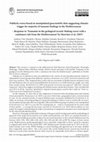
This article is a response to the publication by Nick Marriner, David Kaniewski, Christophe Morha... more This article is a response to the publication by Nick Marriner, David Kaniewski, Christophe Morhange, Clément Flaux, Matthieu Giaime, Matteo Vacchi and James Goff entitled " Tsunamis in the geological record: Making waves with a cautionary tale from the Mediterranean " , published in October 2017 in Science Advances. Making use of radiometric data sets published in the context of selected palaeotsunami studies by independent research groups from different countries, Marriner et al. (2017) carried out statistical and time series analyses. They compared their results with an assessment of Mediterranean storminess since the mid-Holocene that was previously published by Kaniewski et al. (2016) based on a single-core study from coastal Croatia. Marriner et al. (2017) now present " previously unrecognized " 1500-year " tsunami megacycles " which they suggest correlating with Mediterranean climate deterioration. They conclude that up to 90 % of all the 'tsunamis' identified in original tsunami papers used for their study are " better as cribed to periods of heightened storminess ". In this response, we show that (i) the comparison of statistical data describing storm and tsunami events presented by Marriner et al. (2017) is incorrect both from a geographical and a statistical point of view, (ii) the assumed periods of central Mediterranean storminess published by Kaniewski et al. (2016) are missing convincing geological and geochronological evidence and are statistically incorrect, (iii) the palaeotsunami data that was originally collected by different groups of authors were manipulated by Marriner et al. (2017) in a way that the resulting data set – used as a benchmark for the entire study of these authors – is wrong and inaccurate, and that (iv) Marriner et al. (2017) did not address or even negate the original sedimentological studies' presentation of comparative tsunami versus storm deposits for the selected individual localities.
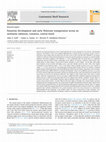
A B S T R A C T Estuaries are important features on the coastal landscape due to their potential ... more A B S T R A C T Estuaries are important features on the coastal landscape due to their potential for rich, diverse, and abundant resources. The modern coast of the southeast Mediterranean is largely devoid of estuaries except in rare circumstances where ample sands are delivered to the shore, such as east of the Nile Delta. Whether or not today's condition is reflective of that present during lower sea-levels is greatly speculative in part due to a dearth of high-resolution sub-surface mapping in the shallower (< 45 m) continental shelf. We report here on a multibeam bathymetry and near-surface seismic stratigraphy survey offshore of Caesarea, along the central Israeli coast; within which we find evidence of preserved estuarine sediments in water depths ~45–10 mbsl, both within paleo-channels of the Crocodile and Hadera rivers, and more broadly across the shelf. These water depths correspond to early Holocene dates (~10.5–7.5 ka) which, based on global sea-level curves, was a period of rapid (~1–1.7 cm/yr) sea-level rise. Now-submerged aeolianite ridges (locally referred to as 'kurkar'), cemented aeolian deposits formed during pre-Last-Glacial-Maximum (LGM) seaward advance (regression) of the coastline, likely provided some offshore barrier for estuarine development. These were insufficient, however, to account for all the estuarine deposition interpreted, leading us to hypothesize that sand-constructed barrier islands were also present as sea-level rose during the Holocene. This supply of sand, clearly greater than what is evident today, could have originated from sea-level rise phase eroding Nile Delta sediments transported northward by littoral currents, or from increased output from local rivers during wetter climatic conditions. We also observe a transition from linear, shore-parallel aeolianite ridge morphology features on land and in shallow water, to nested, arcuate features below ~30 mbsl. Whereas the linear ridges are thought to be coastal foredune remnants abandoned by the retreating shoreline, the arcuate forms resemble fossil parabolic (blowout) dunes. Based on the recent initiation of parabolic dunes on Cape Cod following anthropogenic denudation of forests there, we suggest that climate aridification approaching the LGM could have denuded vegetation along the Israeli coast, enabling parabolic dune formation landward of the coastal foredunes which were later preserved via cementation. Understanding the past landscape of the offshore allows for better reconstruction of dune formation, river channel presence, and identification of habitats conducive to prehistoric human exploitation and settlement.
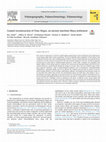
A B S T R A C T Past coastal reconstruction is useful for understanding archaeological coastal se... more A B S T R A C T Past coastal reconstruction is useful for understanding archaeological coastal settlements and predicting how coastal change might affect modern populations. The ancient Maritime Maya inhabitants of Vista Alegre in the northeastern Yucatan were active seafaring peoples. However, the past coastal landscape environmental history is unknown. Previous research concentrated on the fully terrestrial component of the site, and did not approach the issue from an earth sciences, sedimentological perspective. In this study, a sediment core campaign in the shallow offshore of Vista Alegre aimed to reconstruct the coastal and environmental changes that occurred over the past 3000 years, and specifically identify the changes in sea-level. Nine cores were analyzed using a multi-proxy approach including a range of sedimentological parameters such as granulometry, micropaleontology (foraminifera), radiocarbon dating, and loss on ignition. The sediment cores provided an archive of environmental changes related to sea-level change, anthropogenic influence, and shifting microenvironments which can be associated with cultural time periods. The environmental phases and shifts show some linkage to the archaeological chronology, suggesting an association between the environmental conditions and human activities. Sea-level changes and shifting shorelines have always been, and still are, a challenge for coastal settlements, and ancient sites can be a harbinger of what to anticipate in the future. In addition to this, current natural and anthropogenic pressures on coastlines are placing archaeological sites at increasing risk and thereby threatening this important scientific and cultural archive. Therefore, efforts to identify, characterize, and record natural and anthropogenic pressures prior to destruction are increasingly important.
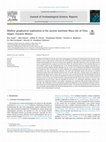
A B S T R A C T Geophysical methods are of great value when investigating or searching for archae... more A B S T R A C T Geophysical methods are of great value when investigating or searching for archaeological sites because of their ability to cover a large area in a short time and reveal features and aspects of unexcavated locations. In submerged archaeological sites, the use of seismic survey methods is especially important, as the excavation process is more complicated than at typical terrestrial sites. While the terrestrial portion of the maritime Maya site of Vista Alegre, located in the northeastern part of the Yucatan Peninsula, has been mapped and partially excavated , the shallow offshore flooded landscape has not, in part due to difficulties determining the best targets for initiating the effort. Results from an earlier sediment core campaign resolved the character, environmental associations, and ages of underlying sediments, but could only minimally predict the presence of laterally continuous features due to the distance between cores. To resolve this issue, a seismic survey was conducted to extrapolate the spatial extent of these strata. The survey area covered the flooded bays flanking the terrestrial portion of Vista Alegre. This area has been affected by sea-level rise throughout time, and was a likely location of maritime activity in the past. Results from this study provided laterally continuous evidence for sea-level rise, reinforcing the previous study; and also identified the presence of a submerged ridge-basin structure. This structure was unexpected because it was neither continuous nor congruous with natural trends observed terrestrially. This uniqueness could be attributed to significant differences in the submerged landscape, and possibly the presence of anthropogenically-altered offshore features. The interpreted seismic data is useful both for a site-scale spatial understanding of the flooded landscape history, as well as for identifying potential locations for shallow water archaeological excavations.
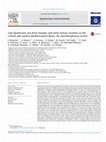
This article reviews key data and debates focused on relative sea-level changes since the Last In... more This article reviews key data and debates focused on relative sea-level changes since the Last Interglacial (approximately the last 132,000 years) in the Mediterranean Basin, and their implications for past human populations. Geological and geomorphological landscape studies are critical to archaeology. Coastal regions provide a wide range of resources to the populations that inhabit them. Coastal landscapes are increasingly the focus of scholarly discussions from the earliest exploitation of littoral resources and early hominin cognition, to the inundation of the earliest permanently settled fishing villages and eventually, formative centres of urbanisation. In the Mediterranean, these would become hubs of maritime transportation that gave rise to the roots of modern seaborne trade. As such, this article represents an original review of both the geo-scientific and archaeological data that specifically relate to sea-level changes and resulting impacts on both physical and cultural landscapes from the Palaeolithic until the emergence of the Classical periods. Our review highlights that the interdisciplinary links between coastal archaeology, geomorphology and sea-level changes are important to explain environmental impacts on coastal human societies and human migration. We review geological indicators of sea level and outline how archaeological features are commonly used as proxies for measuring past sea levels, both gradual changes and catastrophic events. We argue that coastal archaeologists should, as a part of their analyses, incorporate important sea-level concepts, such as indicative meaning. The interpretation of the indicative meaning of Roman fishtanks, for example, plays a critical role in reconstructions of late Holocene Mediterranean sea levels. We identify avenues for future work, which include the consideration of glacial isostatic adjustment (GIA) in addition to coastal tectonics to explain vertical movements of coastlines, more research on Palaeolithic island colonisation, broadening of Palaeolithic studies to include materials from the entire coastal landscape and not just coastal resources, a focus on rescue of archaeological sites under threat by.org/licenses/by-nc-nd/4.0/). Quaternary International 449 (2017) 29e57 coastal change, and expansion of underwater archaeological explorations in combination with submarine geomorphology. This article presents a collaborative synthesis of data, some of which have been collected and analysed by the authors, as the MEDFLOOD (MEDiterranean sea-level change and projection for future FLOODing) community, and highlights key sites, data, concepts and ongoing debates.
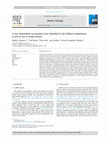
Tsunami field evidence is a critical resource for determining coastal risk. However, in many case... more Tsunami field evidence is a critical resource for determining coastal risk. However, in many cases there is low potential for long term preservation of such deposits on land. A growing body of evidence suggests that tsunami deposits can be present in the shallow offshore realm and may present a largely untapped, but important worldwide sedimentological reference set for investigating past tsunami events. Here, different proxies for tsunami sediment identification and differentiation (granulometry, XRD, XRF, FT-IR) were used to determine the presence or absence of such deposits in a core collected offshore at Jisr al-Zarka, midway between Tel Aviv and Haifa. The study aimed to recognize anomalous deposits and test different analytical methods to define their origins. Five anomalous sedimentological horizons were identified, four of which were interpreted as tsuna-migenic by comparison to previously identified poorly sorted, shell-rich tsunamites found nearby in Caesarea and contrast to the fine-sand, Nile-derived background sediments. The remaining anomaly was distinctive, but not determined to be tsunamigenic due to a lack of coarse shell in the matrix. The oldest tsunamigenic layer, coinciding with the Chalcholithic cultural period (5.7 ka), is the oldest such deposit identified offshore Israel to date and the non-tsunamigenic anomalous horizon may correspond with a transitional climatic phase (~ 5.5 ka). This research reinforces the importance of offshore investigations as a means of improving tsunami catalogues and identifying environment-altering events.
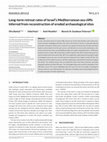
Erosion and inland retreat of coastal cliffs present one of the most dynamic earth-surface proces... more Erosion and inland retreat of coastal cliffs present one of the most dynamic earth-surface processes presently challenging coastlines. The rate of cliff retreat is central to coastal planning and protection of shoreline infrastructure. Until now, the majority of retreat rate estimates have been based on aerial photos from the past century, and therefore do not provide multicentury estimates of retreat rates. Here, we studied Bronze Age to Crusader archeological sites (∼3700 years) located on Israel's coastal cliff and used their spatial relation to the cliff to estimate the long-term centurial-millennial retreat rates of the cliff. To accomplish this, original layouts of partially eroded archaeological structures were reconstructed and compared to the modern coastal cliff line. The eroded parts of the studied structures and their original age constrained the maximum timing of the retreat. The resulting retreat rates are significantly lower than those previously calculated using observations of around 100 years. The archeological data also record the episodicity of the cliff failure events. The research highlights both the issue of the loss of valuable archaeological cultural resources, and simultaneously the usefulness of eroding coastal archaeological features to resolve questions of modern significance.
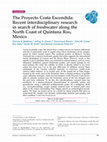
Access to potable water has always been a major concern for human settlement, and this is particu... more Access to potable water has always been a major concern for human settlement, and this is particularly acute in coastal areas where freshwater can be compromised by saline marine waters. The northeast portion of Mexico's Yucatan Peninsula has a massive freshwater aquifer that today supports the international tourist destinations of Cancun and the Riviera Maya. However, access to this aquifer in pre-Columbian times was restricted to natural features, such as cenotes (limestone sinkholes), aguadas (freshwater ponds), and coastal springs, or cultural features like wells, the viability of which is directly linked to sea level, which has risen over 2 m in the past 3000 years. In addition, ancient Maya inhabitants of the Yucatan collected rainwater in reservoirs, smaller-scale cisterns called chultunes, or in ceramic pots. At the coastal site of Vista Alegre, located on the north coast of the Peninsula, there is limited evidence of potable water collection strategies, which has led members of the Proyecto Costa Escon-dida to critically examine how the freshwater access at the site changed over the past three millennia. To do this, the interdisciplinary research team has conducted (1) a physico-chemical characterization of accessible surface and groundwater using a calibrated multiparameter probe, (2) a multiproxy study (i.e., micropaleontology, oxygen isotopic analysis) from 12 manual push cores taken in the waters surrounding Vista Alegre, and (3) an archaeological investigation. We hope our project serves as a model for future projects that strive to understand the complex and dynamic relationships between past peoples and their coastlines.
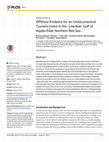
Although the Gulf of Aqaba-Eilat is located in the tectonically active northern Red Sea, it has b... more Although the Gulf of Aqaba-Eilat is located in the tectonically active northern Red Sea, it has been described as low-risk with regard to tsunami activity because there are no modern records of damaging tsunami events and only one tsunami (1068 AD) referred to in historical records. However, this assessment may be poorly informed given that the area was formed by and is located along the seismically active Dead Sea Fault, its population is known to fluctuate in size and literacy in part due to its harsh hyper-arid climate, and there is a dearth of field studies addressing the presence or absence of tsunamigenic deposits. Here we show evidence from two offshore cores for a major paleotsunami that occurred ~2300 years ago with a sedimentological footprint that far exceeds the scarce markers of the historically mentioned 1068 AD event. The interpretation is based on the presence of a laterally continuous and synchronous, anomalous sedimentological deposit that includes allochtonous inclusions and unique structural characteristics. Based on sedimentological parameters, these deposits could not be accounted for by other transport events, or other known background sedimentological processes.
Earth and Planetary Science Letters, 2015
Available online xxxx Editor: J. Lynch-Stieglitz Keywords: hyperarid ephemeral-rivers flashfloods... more Available online xxxx Editor: J. Lynch-Stieglitz Keywords: hyperarid ephemeral-rivers flashfloods hyperpycnal turbidity currents sediments
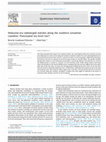
The study presented here reports on erosional notches, pits, and potholes observed at present sea... more The study presented here reports on erosional notches, pits, and potholes observed at present sea level and submerged at a series of sites along the southern Levantine coastline. For such submerged features to be formed and preserved, there must be a period of relative sea level stagnation, followed by drowning. This process can occur in response to sea level change, tectonic or isostatic offsets. The specific coastline hosting these features is not considered tectonically or isostatically affected, and therefore, for much of the Mediterranean, is viewed as a eustatic sea level reference point. While similar features have been observed elsewhere in the eastern Mediterranean, confining their ages has been difficult due to the much older ages of the host rocks, in many cases encompassing multiple glacial cycles. Here, for the first time they are located in relatively young host rock (<65,000 years) confining their production age to the most recent glacial cycle. These features might suggest that a step-like, more punctuated process of sea-level rise occurred along this coastline, providing a window into what might be expected in the future as warming trends continue and the sea level responds.
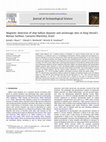
Ballast stone deposits are a common feature of sediments in ancient harbour basins but are often ... more Ballast stone deposits are a common feature of sediments in ancient harbour basins but are often overlooked as a potential source of archaeological information. Recent geophysical investigations at Caesarea Maritima in Israel have discovered a thick, laterally extensive ballast layer in the area seaward of the 1st c. BC Roman harbour. The ballast deposits were identified by low-relief mounds on the seabed with elevated magnetic intensities. Jet probing and excavation of magnetic anomalies at several locations revealed a 20-60 cm thick rubble layer containing large quantities of Late Roman and Byzantine pottery, local sedimentary boulders (kurkar sandstone, limestone cobbles) and foreign igneous and metamorphic boulders (granite, schist, volcanics; ca. 50%). The foreign boulders and pottery identify the rubble layer as ballast and ships refuse jettisoned by merchant ships outside the harbour. The strong magnetic contrast between the ballast deposits and the natural seabed sediments is attributed to the high magnetic susceptibility (>10 À3 SI) of crystalline boulders and pottery materials within the ballast rubble. AMS 14 C and OSL dates and pottery evidence indicate the ballast accumulation began in the Late Roman period (ca. 200-330 AD) and continued well into the Late Byzantine (ca. 7th c. AD). The main phase of ballast deposition (ca. 4th-5th c. AD) coincided with a decline in the state of Caesarea's harbour following a destructive tsunami event in the early 2nd c. AD and records a shift to a more intensive use of the area seaward of the harbour as an anchorage and ballast lightening area.
Journal of Roman Archaeology 23, 2010
Holocene book review: Geoarchaeology: underwater archaeology in the Canopic region in Egypt (Oxford Centre for Maritime Archaeology, Monograph 2) Jean Daniel Stanley, Oxford: Oxbow Books, 2007, 128 pp., US$100.00; 50.00, hardback. ISBN 978-0-9549627-4-6
The Holocene, 2009
The paleogeography of Liman Tepe, Turkey: A multi-proxy geoarcheological study
ETD Collection for McMaster University, 2006
The coastal area of Liman Tepe, Turkey was investigated to determine the changes that have occurr... more The coastal area of Liman Tepe, Turkey was investigated to determine the changes that have occurred in the past 6000 years in order to answer questions related to Bronze Age (4800-3200 BP) natural harboring areas and coastal configuration. Archaeologists (director Dr. Prof. ...
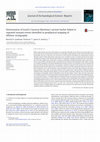
Modern observations have shown that harbors are especially vulnerable to the effects of tsunamis,... more Modern observations have shown that harbors are especially vulnerable to the effects of tsunamis, both due to their position on the coastline and the tendency for tsunamigenic eddy production within enclosed harbor basins. Presumably, this was as much the case in the past as in the present. The Roman-era mega-harbor Caesarea Maritima, which is today submerged in some parts up to 5 m below sea level, is an ideal research site for understanding these impacts. Over the past three decades, archeologists, geologists and historians have searched for the cause of the rapid demise of this harbor, turning to explanations ranging from offshore faults, seismic disturbances, general failure and deterioration, to liquefaction and settling on unconsolidated sands. While tsunamis are recorded repeatedly in the Eastern Mediterranean historical record, it has only been in the past decade that physical evidence directly attributed to tsunamigenic sediments along the Israeli coastline near Caesarea has been documented. To date, deposits from at least three tsunami events that impacted the harbor have been identified in sediment cores, coastal exposures and archeological trenches, but no laterally continuous picture has been produced. In this study, using a dense offshore survey produced by a high-resolution subbottom profiler, shallowly buried sediment horizons offshore of Caesarea produce distinctive reflectors that correlate with the tsunamigenic stratigraphic sequence identified in cores and excavations. These surface structure maps allow for a laterally extensive reconstruction of these distinctive deposits. The results have led to the following conclusions and interpretations: 1) multiple offshore tsunamigenic horizons at Caesarea can be recognized, 2) individual tsunamigenic event horizons result in distinctive and unique surface morphologies that elucidate tsunami-based channeling/backflow processes, and 3) these backwash channels can be used to assess the general physical condition of the harbor at the time of each tsunami occurrence, ultimately revealing major differences between the state of the harbor following earlier events (i.e., 2nd c. CE) vs. later events (6-8th c. CE). We conclude that the combined acoustic-sampling approach is an effective way to document the interaction of tsunamis with harbor complexes/adjacent coastlines over millennia.
Available online xxxx Editor: J. Lynch-Stieglitz Keywords: hyperarid ephemeral-rivers flashfloods... more Available online xxxx Editor: J. Lynch-Stieglitz Keywords: hyperarid ephemeral-rivers flashfloods hyperpycnal turbidity currents sediments
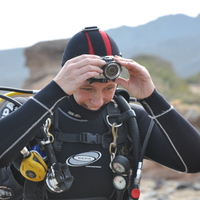
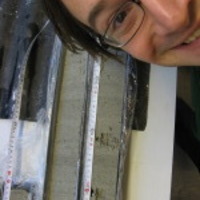


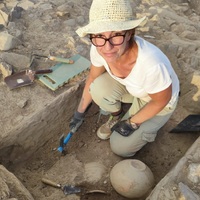





Uploads
Papers by Beverly Goodman
at Çeşme-Bağlararası (Turkey)"
background sediments and between other extreme events. In this pilot study, the potential of Optically Stimulated Luminescence (OSL), normally used as a dating method, is demonstrated and a new potential sedimentological proxy is proposed when analysing in depth the OSL signal from single grain measurements to distinguish between underwater deposits derived from marine extreme events embedded in the texturally and compositionally homogeneous shallow shelf archive of the eastern Mediterranean. Newly and previously collected sediment samples from underwater excavations and a sediment core offshore Caesarea Maritima (Israel) were used in this experiment. Each sample was associated with either tsunami, storm, or fair weather (normal) marine conditions based on multiple proxies. In this study, single grain over-dispersion (SG-OD) values and ranges are used as a potentially novel way to quantify the degree of sedimentary chaos, thus the degree of scatter of the dose distribution as a function of the efficiency of exposure to sunlight (zeroing) of the quartz grains entrained during transport and deposition. Given that turbidity of a fluid should be associated with lower light penetration, and higher energy flowwith greater sediment density (as can occur in tsunamis relative to storms),
these conditions should be reflected in variations in single grain over-dispersion values, hence identifying luminescence distribution patterns related to known depositional conditions. This quantification is coupled
with detailed statistical analysis of the resulting single grain equivalent dose distributions, minimally used in OSL-dating. Three types of underwater deposits were categorised based on three distribution typologies, to which, preliminary, conservative single grain over-dispersion ranges were assigned: b25% for Gaussian-like sands deposited under normal marine conditions; 25–60% for storm-laid sediments depicting bimodal distributions; and N60% for tsunami-related deposits showing asymmetric distributions with strong positive
skewness. This new tool provides a means to study offshore extreme marine events, without potential dismissal of other identification criteria and proxies. Based on these results, single grain over-dispersion OSL could be considered as a potential new sedimentological proxy for identification, comparison and characterisation of marine-derived extreme events in the shallow shelf (such as tsunami deposits), as it is intrinsic to the sediment grain, and the degree of sedimentary chaos of the event itself.
at Çeşme-Bağlararası (Turkey)"
background sediments and between other extreme events. In this pilot study, the potential of Optically Stimulated Luminescence (OSL), normally used as a dating method, is demonstrated and a new potential sedimentological proxy is proposed when analysing in depth the OSL signal from single grain measurements to distinguish between underwater deposits derived from marine extreme events embedded in the texturally and compositionally homogeneous shallow shelf archive of the eastern Mediterranean. Newly and previously collected sediment samples from underwater excavations and a sediment core offshore Caesarea Maritima (Israel) were used in this experiment. Each sample was associated with either tsunami, storm, or fair weather (normal) marine conditions based on multiple proxies. In this study, single grain over-dispersion (SG-OD) values and ranges are used as a potentially novel way to quantify the degree of sedimentary chaos, thus the degree of scatter of the dose distribution as a function of the efficiency of exposure to sunlight (zeroing) of the quartz grains entrained during transport and deposition. Given that turbidity of a fluid should be associated with lower light penetration, and higher energy flowwith greater sediment density (as can occur in tsunamis relative to storms),
these conditions should be reflected in variations in single grain over-dispersion values, hence identifying luminescence distribution patterns related to known depositional conditions. This quantification is coupled
with detailed statistical analysis of the resulting single grain equivalent dose distributions, minimally used in OSL-dating. Three types of underwater deposits were categorised based on three distribution typologies, to which, preliminary, conservative single grain over-dispersion ranges were assigned: b25% for Gaussian-like sands deposited under normal marine conditions; 25–60% for storm-laid sediments depicting bimodal distributions; and N60% for tsunami-related deposits showing asymmetric distributions with strong positive
skewness. This new tool provides a means to study offshore extreme marine events, without potential dismissal of other identification criteria and proxies. Based on these results, single grain over-dispersion OSL could be considered as a potential new sedimentological proxy for identification, comparison and characterisation of marine-derived extreme events in the shallow shelf (such as tsunami deposits), as it is intrinsic to the sediment grain, and the degree of sedimentary chaos of the event itself.